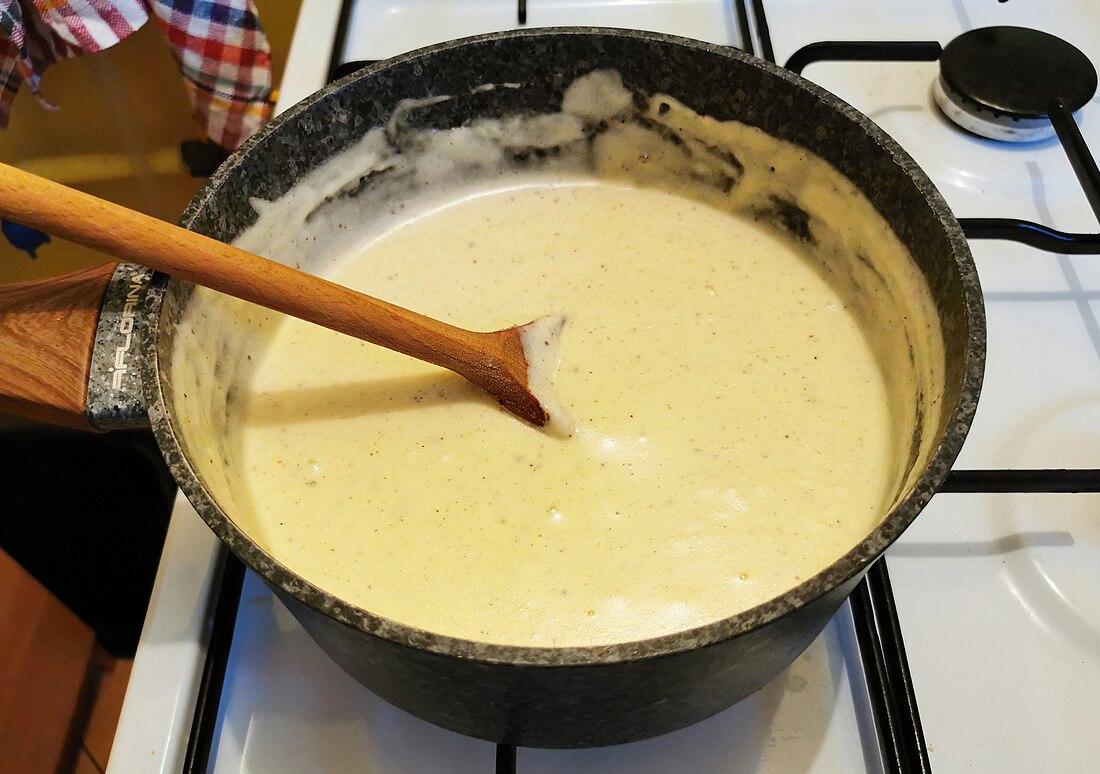French mother sauces
Sauce from which other sauces are derived within the French cooking tradition From Wikipedia, the free encyclopedia
In French cuisine, the mother sauces (French: sauces mères, pronounced [sos mɛʁ]), also known as grandes sauces (pronounced [ɡʁɑ̃d sos]) in French, are a group of sauces upon which many other sauces – "daughter sauces" or petites sauces – are based.[1][2] Different classifications of mother sauces have been proposed since at least the early 19th century.[3]
Sauces considered mother sauces. In order (left to right, top to bottom): béchamel, espagnole, tomato, velouté, hollandaise, and mayonnaise.
Current use
The most common list of mother sauces in current use is:[4][5][6][7]
- Béchamel sauce: White sauce, based on milk thickened with a white roux.
- Espagnole sauce: Brown sauce based on a brown stock reduction, and thickened with a brown roux. Ingredients typically include roasted bones, bacon, and tomato (puréed or fresh).
- Tomato sauce (sometimes Tomate or Tomat): In addition to tomatoes, ingredients typically include carrots, onion, garlic, butter, and flour, plus pork belly and veal broth.
- Velouté sauce: Light coloured sauce, made by reducing clear stock (made from un-roasted bones) and thickened with a white roux. Velouté is French for "velvety".
- Hollandaise sauce: Warm emulsion of egg yolk, melted butter, and lemon juice or vinegar.
- Mayonnaise sauce: Emulsion of egg yolk, oil, and lemon juice or vinegar.
History
Summarize
Perspective
In 1833, Marie-Antoine Carême described four grandes sauces (great sauces).[3] In 1844, the French magazine Revue de Paris reported:
Don’t you know that the grand sauce Espagnole is a mother sauce, of which all the other preparations, such as reductions, stocks, jus, veloutés, essences, and coulis, are, strictly speaking, only derivatives?
— Les Fantaisies du Rocher de Cancale[8]
Different groups of mother and daughter sauces have been proposed by different chefs, varying in number and selection.
| Sauce | Carême | Gouffé | Escoffier | Montagné | Common list | |||
|---|---|---|---|---|---|---|---|---|
| 1833[9] | 1867 | 1903 | Heinemann | 1907 | 1912 | 1938 | (current) | |
| Allemande | ?[12] | |||||||
| Béchamel | ||||||||
| Demi-glace | ||||||||
| Espagnole | ||||||||
| Hollandaise sauce | ||||||||
| Jus de veau lié | ||||||||
| Poivrade | ||||||||
| Marinade | ||||||||
| Mayonnaise | ||||||||
| Mirepoix | ||||||||
| Suprême | ||||||||
| Tomato | ||||||||
| Velouté | ||||||||
Classification by Marie-Antoine Carême (1833)
In 1833, Marie-Antoine Carême published a classification of French sauces in his reference cookbook L’art de la cuisine française au XIXe siècle ("The Art of French Cuisine in the 19th Century"). He called them Grandes et Petites sauces ("great and small sauces").[3]
In this cookbook, Carême defined a sauce classification and listed four grandes sauces:
Carême classified numerous sauces as petites sauces.[3]
Classification by Jules Gouffé (1867)
In 1867, the French chef and pâtissier Jules Gouffé published Le livre de cuisine comprenant la grande cuisine et la cuisine de ménage (The Cookbook Including Grand And Domestic Cooking).[59]
In this book, Gouffé listed twelve mother sauces. (He used both the terms grandes sauces and sauce mères).
- Espagnole Grasse (Fattier Espagnole)
- Espagnole Maigre (Leaner Espagnole)
- Velouté Gras (Fattier Velouté)
- Velouté Maigre (Leaner Velouté)
- Allemande (Velouté thickened with eggs)
- Béchamel à l’ancienne (Old Fashioned Béchamel)
- Béchamel de volaille (Poultry Béchamel)
- Béchamel maigre (Leaner Béchamel)
- Poivrade brune (Brown Poivrade)
- Poivrade Blanche (White Poivrade)
- Poivrade Maigre (Leaner Poivrade)
- Marinade
Classification by Auguste Escoffier (1903)
The pioneering chef Auguste Escoffier is credited with establishing the importance of Espagnole, Velouté, Béchamel and Tomate, as well as Hollandaise and Mayonnaise.[5][60] His book Le guide culinaire was published in 1903. It lists numerous "Grandes Sauces de base", including espagnole, velouté, béchamel, and tomate as well as others such as mirepoix and jus de veau lié (thickened veal stock).[61]
The original French editions of Le guide culinaire listed Hollandaise as a daughter sauce rather than a grande sauce.[33] Mayonnaise, in the chapter on cold sauces, was described as a mother sauce for cold sauces, and compared to Espagnole and Velouté.[50]
The 1907 English edition of Le guide culinaire, A Guide to Modern Cookery, listed fewer "basic sauces", including Hollandaise alongside espagnole, "half glaze" (demi glace), velouté, allemande, béchamel, and tomate.[62] The English edition did not describe mayonnaise as a mother sauce,[63] and included the sentence that "Allemande Sauce is not, strictly speaking, a basic sauce".[18]
Béchamel sauce
Béchamel is a milk-based sauce, thickened with a white roux and typically flavoured with onion, nutmeg, or thyme.[64]
Espagnole sauce
Espagnole is a strong-flavoured brown sauce, made from a dark brown roux and brown stock—usually beef or veal stock—and tomatoes or tomato paste.[64]
Velouté sauce
Velouté is light in colour, made by reducing clear stock (made from un-roasted bones), usually veal, chicken or fish stock, thickened with a white or blond roux. Velouté is the French word for "velvety".[65]
Tomato sauce
The sauce tomate described by Escoffier is a tomato sauce made with fatty salted pork breast, a mirepoix of carrots, onions and thyme, and white stock.[66]
Hollandaise sauce
Hollandaise is a warm emulsion based on egg yolk and clarified butter, flavoured with lemon juice or vinegar.[67]
Béarnaise sauce is a derivation of hollandaise.
See also
- List of sauces
- Obe ata, a West African sauce used as a mother sauce
References
External links
Wikiwand - on
Seamless Wikipedia browsing. On steroids.






